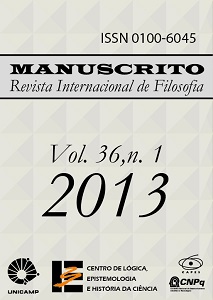Resumo
Las tesis de la indeterminación de Quine establecen que las condiciones de verdad de una oración sub-determinan la referencia de los términos que ocurren en la misma. La cuestión es ¿cuál es el alcance de esa sub-determinación? En Reason, Truth and History Putnam señala que la su-determinación es mayor de lo que podría suponerse a partir de los argumentos de Quine y se propone, con su “argumento modelo teorético”, prolongar radicalmente estos resultados. En este artículo pretendo mostrar que el argumento modelo teorético de Putnam no es una mera prolongación de los resultados de Quine, sino que se trata de un argumento que supone un modelo de interpretación distinto del que subyace al argumento de este último. Si estoy en lo cierto, tendríamos en este caso dos modos de entender la interpretación y dependerá de qué modo la entendamos, el alcance que le demos a la sub-determinación de la referencia por los valores veritativos. Considero, por lo tanto, que el argumento de Putnam, si bien radicaliza las conclusiones de Quine, lo hace introduciendo un modelo de interpretación diferente al que es desarrollado en Word and Object.
Abstract:
Quine's thesis of indeterminacy states that the truth conditions of a sentence sub-determine the reference of the terms that occur in it. The question is: what is the scope of that sub-determination? In Reason, Truth and History Putnam claims that the sub-determination is greater than might be expected from Quine’s arguments and proposes, with his "argument theoretical model," to radically extend these results. In this article I show that the theoretical model of Putnam’s argument is not a mere extension of Quine results, but it is an argument that represents a different interpretation of the model underlying the latter argument. If I'm right, there would be two ways of understanding the interpretation and, depending on how we understand it, the extension of the sub- determination or the reference for truth values. I believe therefore that, although Putnam's argumentrepresents a radicalization of Quine’s conclusions, it introduces an interpretation model different from the one developed in Word and Object.
Keywords: Quine. Putnam. Interpretation. Model theoretical argument. Meaning. Indeterminacy.
Referências
PUTNAM, H. Reason, Truth and History. Cambridge University Press, 1981. Versión española Reason, Truth and History. Edit. Tecnos, Madrid, España 1988.
QUINE, W. Word and Object. The Massachusetts Institut of Technology Press, USA, 1960.
QUINE, W. “Los hechos relevantes” en Quine (2001).
QUINE, W. “Tres indeterminaciones” en Quine (2001).
QUINE, W. Ontological Relativity and Other Essays. Columbia University Press, N.Y., 1969.
QUINE, W Acerca del conicimiento científico y otros dogmas. Paidós, Barcelona, 2001.
QUINE, W. Theories and Things. Harvard University Press, 1981.

